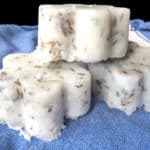DIY Easy Bar Soap
This recipe makes a loaf-pan size amount of soap. In the video I used something similar to this mold and a flower mold (of which I can't remember for the life of me where I purchased), which yielded 6 flowers and 9 rectangles.
Materials
- 33 oz coconut oil extra virgin. I buy mine at Costco or you can get it here
- 4.83 ounces lye I buy this one
- 12.54 oz water
- .5 – 1 ounce essential oils optional
Instructions
- Weigh out the coconut oil and place in the crockpot. Turn on the crockpot to HI or LOW. Mine is old so I use the HI setting.
- Mix the lye with the water. TO DO THIS: Pour water into a glass bowl or measuring cup and take outside. I like to do this outside where it's well ventilated and away from my kids.
- With your protective gear on, i.e. rubber household gloves and safety glasses or goggles, gently sprinkle the measured lye INTO the water. NOT the other way around. ***
- Carefully stir the lye solution. Let it set outside for about 10 minutes. The lye solution will become clear when it's fully dissolved.
- Slowly and carefully add lye solution to melted coconut oil in the crockpot. Stir a few times to incorporate.
- Using an immersion blender, blend mixture until trace is achieved (a thickness like pudding)
- Cover the crockpot and continue to cook for 1 hour. During this time the soap mixture will rise and fold onto itself.
- After the soap has cooked long enough, it will appear slightly translucent. You can use PH strips to test if it's done (PH of 7-10), but I like to use the easy DIY test: take a small piece of the cooked soap in between your fingertips. It should feel like wax. Touch it to your tongue. If you get a zap, or intense sting feeling, it's not done. Cook an additional 20 min. and check again. I've never had this happen, however.
- If you're adding essential oils, do that now and stir in well. I don't always add oils. This time I did. I used .5 oz of anise and .5 oz ylang ylang essential oils.
- Pour your soap into a silicone loaf pan, parchment paper-lined loaf pan, or other mold of choice. I like to use silicone molds because of their ease and fun shapes. But when I first started, all I had was my trusty pyrex glass loaf pan.
- Once the soap is cooled and firm, pop out of the molds, or if using a loaf pan, slice into bars. It's important to slice your coconut oil soap once it's firm. If you wait too long it will become very hard and thus difficult to slice into bars.
- Place the bars onto wire racks with space for airflow. Let sit for a few days to finish curing. Although, I usually use a bar right away because... well, out of soap. It works great!
Notes
“It’s smarter to add lye to water! Add water to lye and you may die!” This is a popular rhyme to help you remember the order in which to mix your lye solution. In the Lye Safety Guide article, the Soap Queen gives this explanation: "Mixing water and lye creates an exothermic reaction that causes a dramatic temperature increase." Hence the reason we never want to add water to lye. "Doing so can cause the lye to expand, or erupt, out of the container." I always place a large stainless steel bowl in my sink filled with 3 parts water to 1 part distilled vinegar. This is used to deactivate all my utensils and bowls that come in contact with lye during the process. I then wash everything thoroughly with soap and water. It's important to wipe down all tools, counters and equipment used with vinegar. I always have a spray bottle of vinegar and water, since that's what I use to clean my house.
